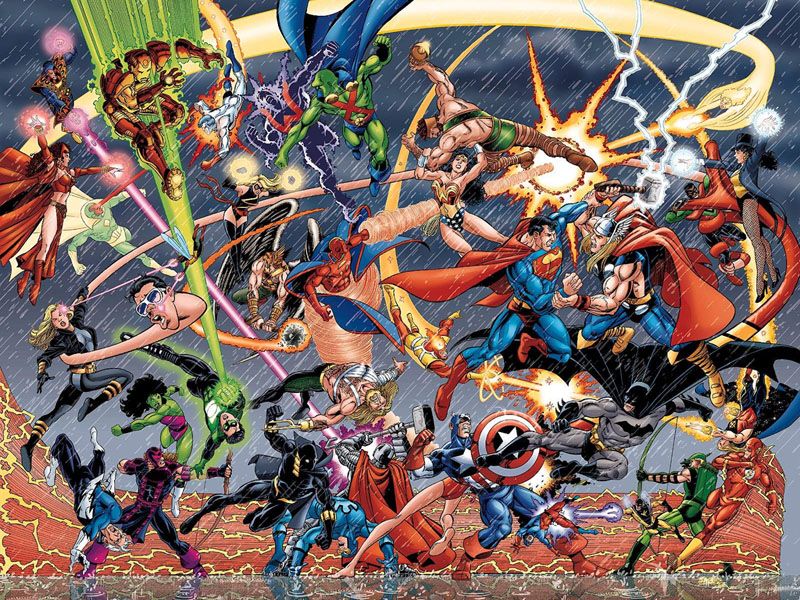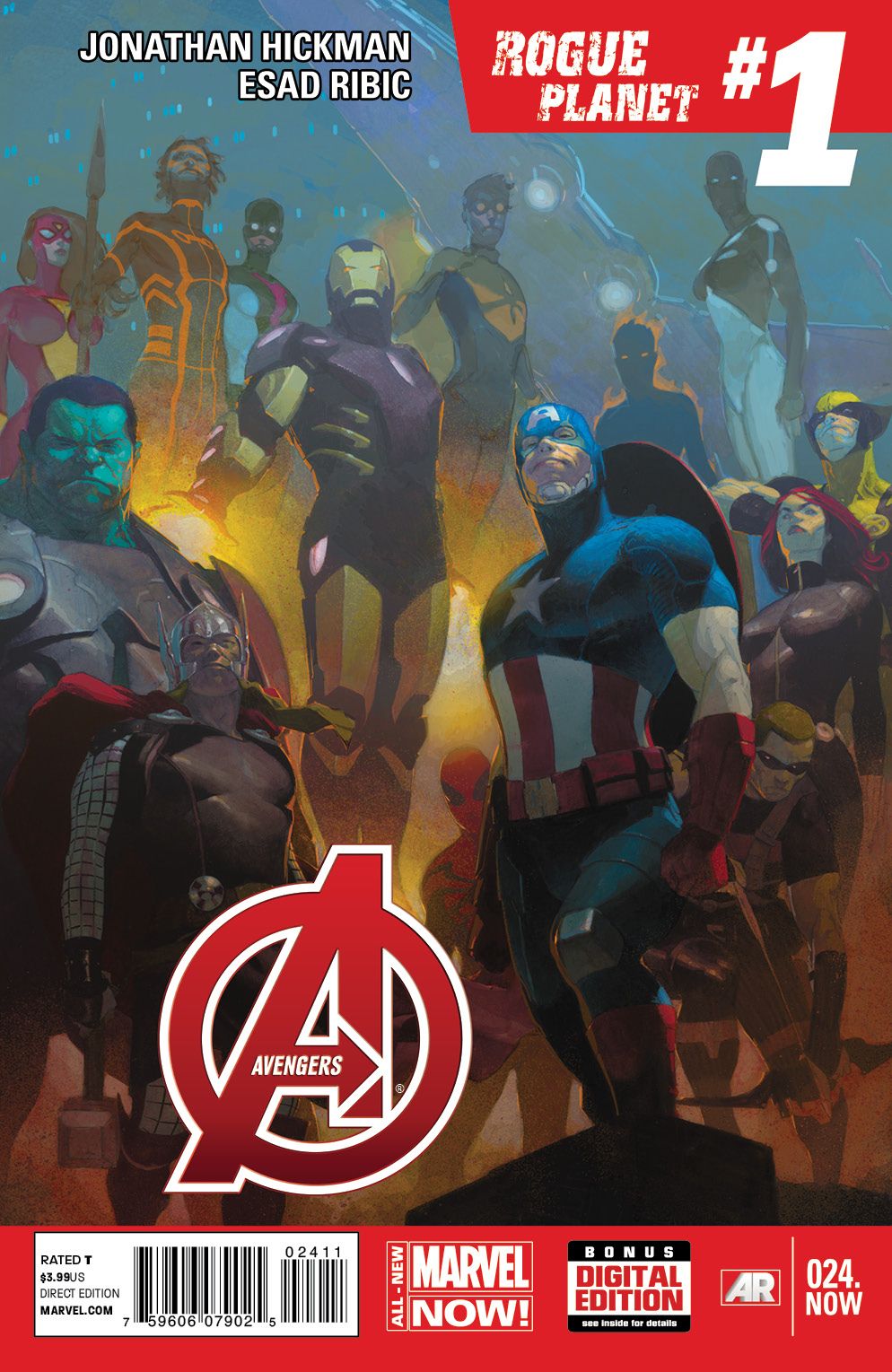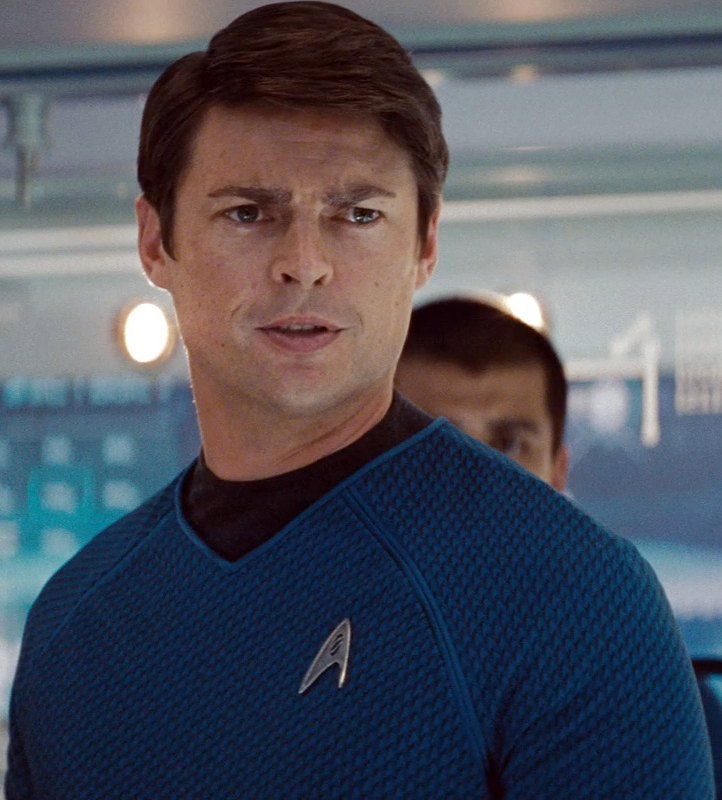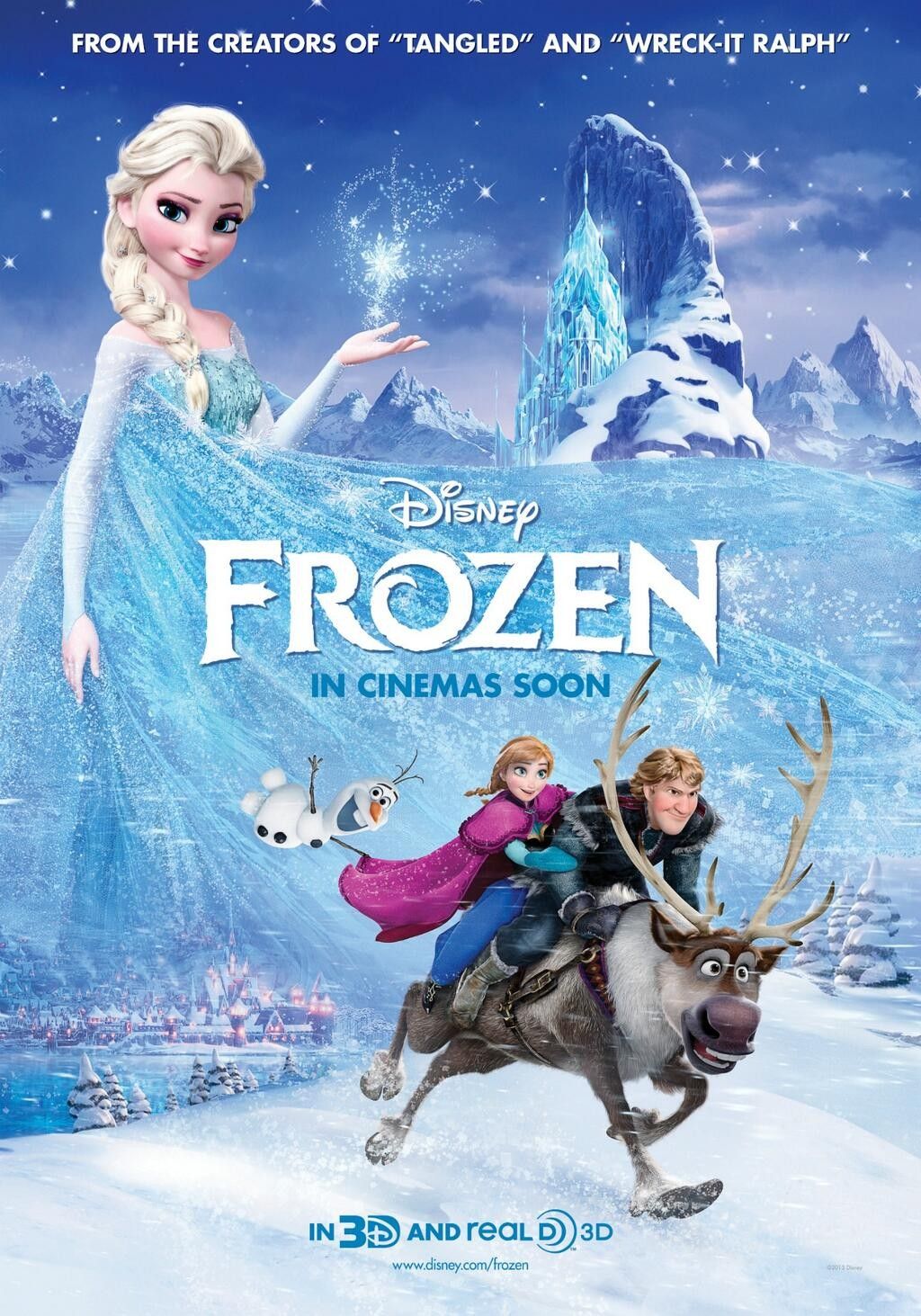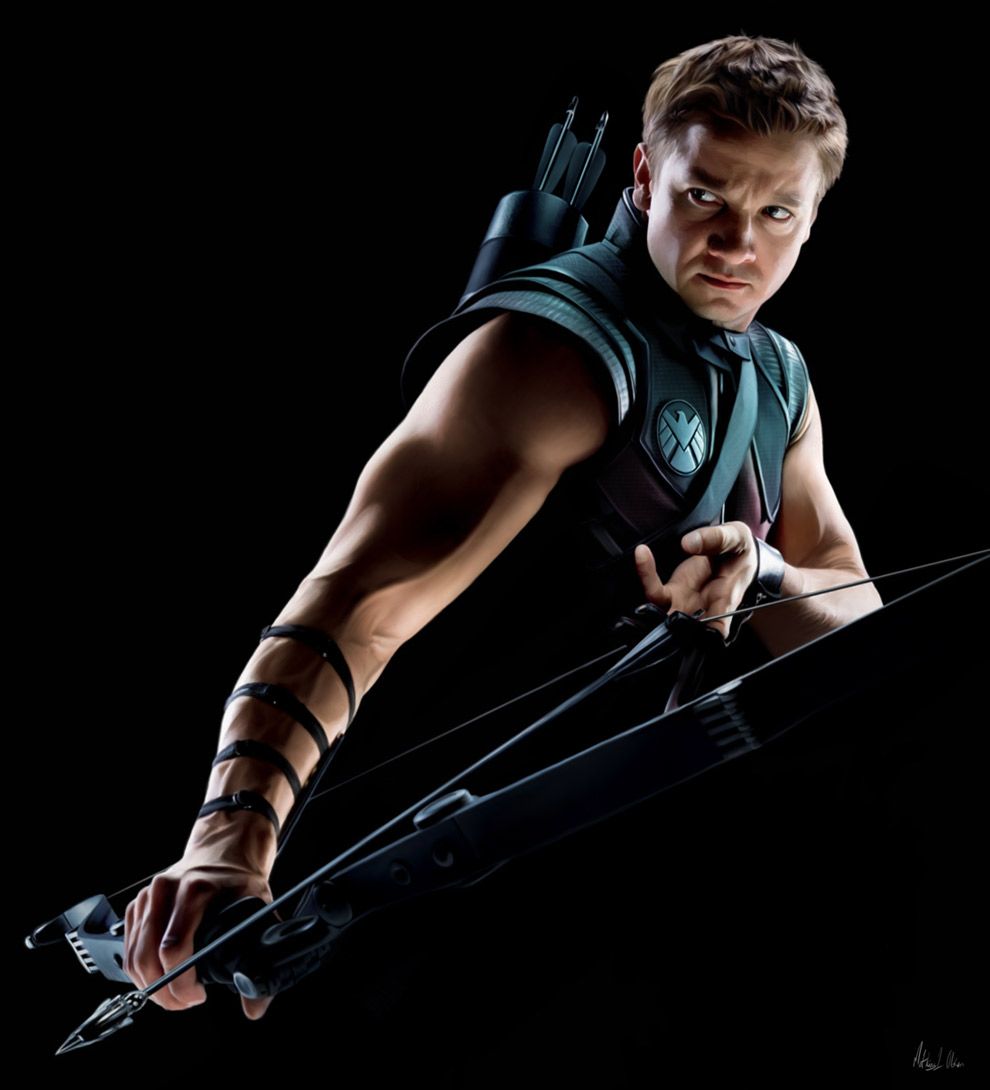Every year ROBOT 6 contributors Tom Bondurant and Carla Hoffman get together to talk about everything in Big Two superhero comics. Watch for Part 2 on Thursday.
Carla: Is it me or was 2013 crazy-busy? There were event comics, new titles, canceled titles, movies (plural for Marvel!), TV shows and video games. It seems like there’s no escape from comics, making it harder and harder to get a general idea of the industry. Some days I kind of envy the indie comic fans as it must be a lot easier to handle comics as they come, as opposed to our gestalt juggernaut that is the Big Two. How much DC business could you comfortably follow before overwhelm set in?
Tom: Well, for starters, I pretty much skipped all of the video game and Cartoon Network developments, because I don’t have time for either area.
Carla: Really? Even I thought Young Justice was amazing, and I’m not even the right demographic (but more on that later). Batman: Arkham Origins was a fun little cash grab to make people play Batman: Arkham City again, and has one of the most intriguing ways to describe the Joker’s origin through his own madness that would border on the cinematic if it wasn’t so linear. Here’s that part of the game, it’s really fascinating ...
Injustice: Gods Among Us was a way for me to understand non-comic fans’ interest in superheroes. They have little to no understanding of the context of these characters other than what we can make them do in the moment. Kind of the way kids play with action figures by just smashing them into one another and making up the story as they go along. In Injustice’s case, it was more like a really disturbed child’s playtime, but hey. The fighting game mechanics were pretty fun and the idea that downloadable content could have Batgirl and Lobo was neat to play around with. The comic tie-in was laughable and gruesome, but again: give the people what they want, right?
Tom: I’ll take your word for it. I am trying to get more into the TV material. Just in the past few weeks I’ve started binge-watching Arrow, and I’m a little over halfway through the first season. (I’m also catching up on Doctor Who, which works out because they’re so different in tone.) At the risk of sounding too elitist, I try to focus on the comics themselves, but sometimes it is literally the least I can do. Of course, these days that involves a good bit of corporate maneuvers, and with DC’s impending move West -- which, ironically, puts ‘em a lot closer to you than to me -- I think there’ll be a lot of that to sort out as the new year unfolds.
Carla: Considering all the editorial news that’s been around this year, the least I can do is still a lot!
OK, I think this is more of an issue on the Marvel end of the Big Two since DC restarted all their books a couple years ago, but what’s your take on the numbering debate? Tom Brevoort believes that continuous numbering has had its day and that we need a new way to sequence our stories. Renumbering for every new arc, new creative team, perhaps new year? Thoughts?
Tom: I am all for keeping the original numbering unless a new No. 1 is just unavoidable. I think it helps justify a series’ existence, in that if you’re going to publish periodicals called Action Comics or Avengers, you ought to just own the fact that you’ve published comics called Action Comics and Avengers for however-many years. And if you’re going to publish multiple comics about the same character, those comics need to be clearly distinct from each other, in more ways that just a new creative team, or you might as well just publish the same comic multiple times a month (as Marvel finally did with Amazing Spider-Man). The basic point of numbering is to establish a reading order, so that when someone goes onto Amazon or comiXology, or even into a retro brick-and-mortar “shop” of some kind --
Carla: *GASP!*
Tom: -- that’s the kind of thing that might help them decide which of the many, many Big Two superhero comics they might want to buy. They don’t need to be confused by multiple “No. 1" issues -- or multiple “Vol. 1" collections, for that matter. And if they do get a little intimidated by the sheer volume of DC and Marvel output, hopefully there’s some friendly, knowledgeable person at the shop to help them.
Carla: *DOUBLE GASP!*
I know, it seems so easy right? That’s how we got into comics (unless your origin story has you finding a new #1 on the stands -- the first comic I ever bought was X-Men #24), so why can’t everyone else do the same? Numbers are sequential, numbers aid in establishing the continuity of a serialized story, and that’s where we have our problem. Continuity is off-putting to the new generation of comic readers and is a big reason why the New 52 isn’t just a Crisis memory by now. Comic storylines are ... not really as serialized as we remember them; arcs are now stretched out further over multiple issues and end and start again in completely different locations. Marvel has a habit of writing for the trade paperback, which is great for people who don’t want to follow month by month, but not so great for someone who wants to try out a few issues before committing to a series. As someone who files comics for a living, I hate hate hate hate renumbering. As someone who tries to get new comic converts, I can see how a shiny new #1 can help sales.
Tom: All those fannish, bookkeeping reasons seem to have gotten lost in the idea that high numbers are bad, and new No. 1s are best of all. Like what you’re saying, it goes back to the ‘90s notion that every issue can potentially be a collector’s item (don’t worry, we’ll get into the crazy decimal-point numbering later), and a No. 1 on the cover is just another way to do that. I may be in denial on this, but I remain unconvinced that a “first issue” means what the Direct Market seems to think it means.
Carla: I agree, mostly. First issues, almost as a rule, suck as a way to hook new readers. There is rarely but a morsel of what the story is going to contain, which can either disappoint a new reader and plummet sales of issue two, or can be so good that the pace can’t be sustained through continuing issues and the series with promise gets canceled.
But #1 issues work. It’s true! They bring attention to characters that would go unconsidered, bring prestige to creators that might get lost in a longer numbering’s shuffle, and highlight a big push in stylistic changes as a whole. If it didn’t sell comics, the Big Two wouldn’t keep doing it. Still, there’s got to be a better way; I’ve been thinking if we can keep the indicia numbering consistent instead of the number on the cover, that might be a way to have that cake and eat it too. The cover tells the potential buyer what they need to know and the fine print in the comic speaks more about the issue’s origin in the company at large. They could call the book Spider-Man #1.SGBKJVSKRKJRKJ for all I care, I just want to know what order they should go in.
Movies, movies, movies, Tom! We had a blockbuster year with Man of Steel and Iron Man 3 and Thor: The Dark World. Yeah, weird to think that Iron Man 3 came out this year, isn’t it? How do you think DC fares at the box office these days? Think the Trinity movie -- I mean, Batman vs. Superman (co-starring Wonder Woman) is going to handle DC’s biggest stars?
And, on a side note: Star Trek Into Darkness -- that also happened this year. What’d ya think?
Tom: Maybe we can get special dispensation to do a proper discussion of Into Darkness. For the most part I liked it, but I’m hopeful that this means Abrams & Co. got their Wrath of Khan love out of their collective system. I mean, the first movie was practically an inverse of WOK (with callbacks galore) --
Carla: WHAAAT? There was only one callback to WOK in the first NuTrek movie and it was a callback to something that hadn’t been fleshed out when it was first brought up! It was pleasantly subtle Easter egg for anyone who knew what the Kobayashi Maru was, and a clear illustration of Kirk’s win-at-all-costs attitude. They even cut the line about his medal being for Original Thinking at the end of the movie!
Let’s put it this way: Chapel was a blink-and-you’ll-miss-it cameo in the first movie and a talking point to show how much of a womanizer Kirk is in the second. One was subtle, the other was a bludgeon.
Tom: OK, a brief digression.
The way I see it, ST ‘09 is basically a prequel to WOK. It’s the movie that encapsulates the Kirk-that-was which WOK’s Kirk laments to David. “I’ve patted myself on the back [etc.] ... I know nothing.” It puts Old Spock in the Old Kirk role, with Nero as Khan (Nero even blames Spock for his wife’s death). Spock then “cheats” by giving Kirk and Scotty the keys to manipulating Young Spock and getting in command of the Enterprise. It has the Kobayashi Maru (complete with Kirk’s apple snack), but it also has “I have been, and always shall be, your friend.” (Gets me every time.) More importantly, it sets Kirk up as the guy who can, for lack of a better term, cheat his way out of trouble, so ST: ID needs to take him down a peg by confronting him with Section 31, which exists basically to circumvent Starfleet regulations. Pike punishes Kirk for violating the Prime Directive, but Admiral Marcus sees that he can use Kirk to start a war with the Klingons and get rid of Khan at the same time -- and Kirk will be a plausible patsy because he’s already a loose cannon. While I saw ID twice in the theaters, I haven’t had a chance to watch it on video since then (although I have owned it since September -- this is the world of parenthood). However, I suspect the Kirk at the end of ID is closer to the “real” Kirk of the TV series (who could use regulations to his advantage) than the roguish legend deconstructed in ST II and ST III.
Besides, ID felt like it had to set up you-know-who as the ultimate Kirk rite-of-passage, only at the beginning of his career rather than the end. I understand there are people who hate it, and I know from whence they come, but I am not one of them.
Carla: I can’t say I hate it. I can’t say that it’s worse than Star Trek: Insurrection, the worst Star Trek movie ever conceived by mankind. But I can say that I was shockingly disappointed in what the movie tried to do and tell us as viewers. Everything was going so well for the first movie and the second had to strike a sour note in a new franchise.
Tom: Well, as long as we’re talking Trek, I do think it’s a shame that the Fox show called Bones isn’t the Fox show starring a cranky Karl Urban.
Carla: I’m glad I’m not the only one who thought that.
Tom: I guess I am in the same “I liked it but I respect you not liking it” camp with regard to Man of Steel. The sequel may end up being very crowded and cluttered (in a way that Avengers wasn’t) because it still has to lay the groundwork for this being a superhero universe, as opposed to a “Superman” universe.
Carla: My question is why? Why make Superman bear the load that Marvel let four other heroes work on through separate films? It makes me think someone has a vote of no confidence on superhero films at Warner Brothers so they’re trying to put as much in the next movie as they can so they can keep all their copyrights or some such. That or they just want to catch up to the Avengers faster at their own game, which seems like a bad idea considering Marvel’s lead.
Tom: I think there’s some truth to the “vote of no confidence.” A big part of me thinks Frank Miller ruined Superman (in Dark Knight, of course) by making him a government chump who was Batman’s final big-boss opponent. As long as darker characters are seen as cooler, Superman’s sunny side will need some justification. However, the MOS sequel may actually need to have Batman and Wonder Woman “lighten up,” because -- unless all three of them go on neck-snapping sprees --
Carla: Something I can’t honestly discount, sadly.
Tom: -- Superman still has to lead us Earthlings to enlightenment, and he can’t look like a chump in his own movie. In any event, I suspect Batman and Wonder Woman will be responding to the destruction at the end of MOS. Specifically, Wonder Woman may show up to say “there’s a whole island just like me, so watch out” -- which may not be the best way to introduce her, but it’s probably pretty expedient.
Carla: Tom, no matter what’s done with Wonder Woman, I don’t think it can be the best anything. Seeing the reactions to her being cast into this movie has taught me that you really can’t please a majority.
Tom: I kinda hope they treat Wonder Woman as famous enough not to need much introduction. Everyone knows Wonder Woman, even if all they know is Lynda Carter. However, the DC and Marvel screen adaptations seem to have switched up the publishers’ traditional strengths. Marvel now does better with standalone movies (even if they do feed into each other), while I’d say DC’s serialized TV fare (animated included) has been better-received than Marvel’s.
Carla: Too true. I haven’t even seen Hulk: Agents of S.M.A.S.H., and yet I’ve been told that’s where Paul Dini is now ...
Tom: Before we get off the topic, the best superhero movie I saw this year might just have been Frozen, which upended the old Disney-princess formula very cleverly, mostly by making one of the princesses hated and feared by those she’s sworn to protect. Maybe it was just me, but I saw some Claremont and a little Watchmen in the plotting. The snowman even had a healing factor, sort of, and he was played by a Broadway star to boot ...
Carla: Still need to see that, too!
Wow, I finally get to talk about TV shows! After Marvel’s sad absence from the small screen, we have Marvel’s Agents of S.H.I.E.L.D. and, despite others’ misgivings, I kind of like it. Yes, there’s a lot of Whedonisms to get through but I thought the show’s done pretty well for what it can do: show off the linking side character of the MCU and Joss Whedon’s unique ensemble nerd magic. Will it have a ton of fan service for the Merry Marvel Marching Society? Probably not; ABC and Disney probably wanted to the show to stand on its own legs first before grabbing the Official Handbook and flinging about names. Sure, some of the characters are annoying but as the show goes on, I learn more about them and my irritation lessens. It’s rough around the edges, but Marvel has a lot of rust in the TV show department so I’m willing to wait and see.
How’s Arrow treating you? It’s been recommended to me by quite a few customers at the store and has sort of come into a more prominent view these days with Flash on his way...
Tom: What I have seen of Arrow -- which, again, is a bare majority of Season 1 -- is fairly engaging. It’s not as painfully-aware as Smallville was, and it handles all the DC Easter eggs pretty well. (My favorite so far was a reference to taking “Broome Air” to Coast City.) Sometimes it’s like a Christopher Nolan production of Gossip Girl, but generally it works hard to be serious without being humorless. Also, it doesn’t hurt that the show looks fabulous, and the action is shot pretty well. A guy leaping around putting arrows into people, while bad guys try to fill him full o’ lead, doesn’t come off as awkwardly as you might think.
Carla: I know, right?
Tom: Speaking of the Marvel Movieverse, my problem with S.H.I.E.L.D. goes back to the Graviton episode, where Skye has to infiltrate the party at the mansion. It reminded me of Alias, which had Jennifer Garner do something similar just about every episode; but Alias could look ten times better than S.H.I.E.L.D. does, with probably half the budget.
Carla: Really? I didn’t think the show looked that bad, maybe I didn’t watch enough Alias? Or maybe Joss Whedon shows have always used action scenes as filler to a more emotional and character driven story. No one remembers Firefly for the bitchin’ special effects (though bitchin’ they were).
Tom: Alias is streaming on Netflix, and I recommend at least the first two seasons. The last three each have some problems, although Season Four is the best of those. I don’t know that I’d call it “Whedonesque,” but it definitely doesn’t skimp on character moments just to fit in more action. Plus, it’s not so much that S.H.I.E.L.D. looks bad, but Alias just looked so good.
I guess I don’t mind the dearth of MU references, I’m just hoping S.H.I.E.L.D. gets into a decent groove. (And I have to catch up on the last three episodes, thanks to all the Arrow and Doctor Who.)
Carla: I have hope. Talk to me in a year and that hope might be right out the window, but yeah. Now I have hope.
Tom: What did you think about DC’s Villains’ Month? To me it ended up being a pretty egregious exercise of editorial power, like from now on, every September has to be something flashy. Generally I don’t think it served the ongoing series very well. Not every series was represented, the decimal-point numbering tried to get readers (and retailers) to pick up issues they’d otherwise avoid, it was hit-or-miss as to whether a particular issue fed back into a particular ongoing storyline, and after a while the emphasis on bad deeds and bad outcomes just got depressing. It seemed like about as naked a cash grab as DC could muster, which would have been acceptable had the stories been better. But hey, 3D covers!
Carla: The 3D covers were such a bust at my store. In fact, I can’t really think of too many of the Forever Evil titles we ran out of, meaning we either ordered up on everything (not the case, I can guarantee) or people picked and chose what villains they cared about and didn’t take the series seriously as a linewide event.
As for how egregious it was, well ... Tom, I’d like to introduce you to what’s known as a non-event. Some big storyline that’s hyped as absolutely essential with all the bells and whistles of fresh new stories that will totally change the universe as you know it, cracking the internet in half to herald the end times when, really, it’s a thin plot stretch among a variety of disparate titles to boost their sales. Marvel has these ... more than I’d like to admit. Age of Ultron, for one, changed very little aside from a theme of ‘broken time’ to run in the background of a few Marvel titles, but it was hyped for years as this big Bendis thing that was going to change the Avengers as we know them. Was it a waste of time? That’s for the readers to decide. Me, I didn’t bother with Villains’ Month. Lenticular covers do nothing for me.
Tom: Since you mentioned Age of Ultron, could DC have gotten away with 52 decimal-point tie-ins to Forever Evil, along the lines of the AU issues? And hey, is Marvel going to keep inventing new “domain names” for its tie-ins? And whatever came of AU’s time-travel shenanigans?
Carla: Huh, I had forgotten about that; Age of Ultron did accomplish something rather unique in that it told it’s big universe spanning story without derailing any of the regular titles' storylines. If you wanted to read the Age of Ultron tie-in, you could; if you didn’t care, Spider-Man kept his own tales rolling along. That’s kind of nice now that I look back on it. A bit confusing at first, mostly because we’re so used to griping about big events busting up all our ongoing titles, but hey. It all worked out.
The decimal numbering is ... weird. It looks weird. But if Forbush Man #14.NOW-ER keeps from having to file a Forbush Man vol. 12 #1, I’ll take it. DC might do best to sit this one out and see if Marvel call pull this one off first with readers before attempting to domain name their books. It’s still in development.
As for Age of Ultron, well ... we’re waiting to see if someone can slap a big bandaid on time just yet. Maybe that dead Watcher has something to do with that?
Stay tuned for Part 2, where there are no dead Watchers, but more talk about the year in superheroes!

